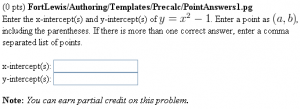Difference between revisions of "PointAnswers1"
(Created page with '<h2>Answer is a Point or a List of Points</h2> <p style="background-color:#eeeeee;border:black solid 1px;padding:3px;"> This PG code shows how to evaluate answers that are point…') |
Paultpearson (talk | contribs) (PGML example link) |
||
| (5 intermediate revisions by 2 users not shown) | |||
| Line 1: | Line 1: | ||
<h2>Answer is a Point or a List of Points</h2> |
<h2>Answer is a Point or a List of Points</h2> |
||
| − | <p style="background-color:#eeeeee;border:black solid 1px;padding:3px;"> |
||
| + | [[File:PointAnswers1.png|300px|thumb|right|Click to enlarge]] |
||
| + | <p style="background-color:#f9f9f9;border:black solid 1px;padding:3px;"> |
||
This PG code shows how to evaluate answers that are points or lists of points. |
This PG code shows how to evaluate answers that are points or lists of points. |
||
| − | <ul> |
||
| − | <li>Download file: [[File:PointAnswers1.txt]] (change the file extension from txt to pg when you save it)</li> |
||
| − | <li>File location in NPL: <code>NationalProblemLibrary/FortLewis/Authoring/Templates/Precalc/PointAnswers1.pg</code></li> |
||
| − | </ul> |
||
</p> |
</p> |
||
| + | * File location in OPL: [https://github.com/openwebwork/webwork-open-problem-library/blob/master/OpenProblemLibrary/FortLewis/Authoring/Templates/Precalc/PointAnswers1.pg FortLewis/Authoring/Templates/Precalc/PointAnswers1.pg] |
||
| + | * PGML location in OPL: [https://github.com/openwebwork/webwork-open-problem-library/blob/master/OpenProblemLibrary/FortLewis/Authoring/Templates/Precalc/PointAnswers1_PGML.pg FortLewis/Authoring/Templates/Precalc/PointAnswers1_PGML.pg] |
||
| + | <br clear="all" /> |
||
<p style="text-align:center;"> |
<p style="text-align:center;"> |
||
[[SubjectAreaTemplates|Templates by Subject Area]] |
[[SubjectAreaTemplates|Templates by Subject Area]] |
||
| Line 45: | Line 45: | ||
"PGstandard.pl", |
"PGstandard.pl", |
||
"MathObjects.pl", |
"MathObjects.pl", |
||
| + | "AnswerFormatHelp.pl", |
||
"contextLimitedPoint.pl", |
"contextLimitedPoint.pl", |
||
); |
); |
||
| Line 81: | Line 82: | ||
points as if they were vectors). The x-intercepts are clearly a |
points as if they were vectors). The x-intercepts are clearly a |
||
list of points. We used a list with only one element for the y-intercepts |
list of points. We used a list with only one element for the y-intercepts |
||
| − | so that a student who mistakenly enters two points will |
+ | so that a student who mistakenly enters two points will be told |
| − | + | their second point is incorrect. If we did not use a list for |
|
| + | the y-intercepts, a student who enters two points would be given |
||
| + | an error message instead. |
||
</p> |
</p> |
||
</td> |
</td> |
||
| Line 112: | Line 113: | ||
<p> |
<p> |
||
<b>Main Text:</b> |
<b>Main Text:</b> |
||
| + | Be sure to tell students the proper syntax for how to enter their answers. |
||
</p> |
</p> |
||
</td> |
</td> |
||
| Line 164: | Line 166: | ||
[[Category:Top]] |
[[Category:Top]] |
||
| − | [[Category: |
+ | [[Category:Sample Problems]] |
| + | [[Category:Subject Area Templates]] |
||
Revision as of 21:24, 13 June 2015
Answer is a Point or a List of Points
This PG code shows how to evaluate answers that are points or lists of points.
- File location in OPL: FortLewis/Authoring/Templates/Precalc/PointAnswers1.pg
- PGML location in OPL: FortLewis/Authoring/Templates/Precalc/PointAnswers1_PGML.pg
| PG problem file | Explanation |
|---|---|
|
Problem tagging: |
|
DOCUMENT(); loadMacros( "PGstandard.pl", "MathObjects.pl", "AnswerFormatHelp.pl", "contextLimitedPoint.pl", ); TEXT(beginproblem()); |
Initialization:
We only need to load |
Context("LimitedPoint");
$f = Compute("x^2-1");
$xint = List( Point("(1,0)"), Point("(-1,0)") );
$yint = List( Point("(0,-1)") );
|
Setup:
We could have used |
Context()->texStrings;
BEGIN_TEXT
Enter the x-intercept(s) and y-intercept(s)
of \( y = $f \). Enter a point as \( (a,b) \),
including the parentheses. If there is more
than one correct answer, enter a comma
separated list of points.
$BR
$BR
x-intercept(s): \{ ans_rule(20) \}
\{ AnswerFormatHelp("points") \}
$BR
y-intercept(s): \{ ans_rule(20) \}
\{ AnswerFormatHelp("points") \}
END_TEXT
Context()->normalStrings;
|
Main Text: Be sure to tell students the proper syntax for how to enter their answers. |
$showPartialCorrectAnswers = 1; ANS( $xint->cmp() ); ANS( $yint->cmp() ); |
Answer Evaluation: |
Context()->texStrings;
BEGIN_SOLUTION
${PAR}SOLUTION:${PAR}
Solution explanation goes here.
END_SOLUTION
Context()->normalStrings;
COMMENT('MathObject version.');
ENDDOCUMENT();
|
Solution: |
